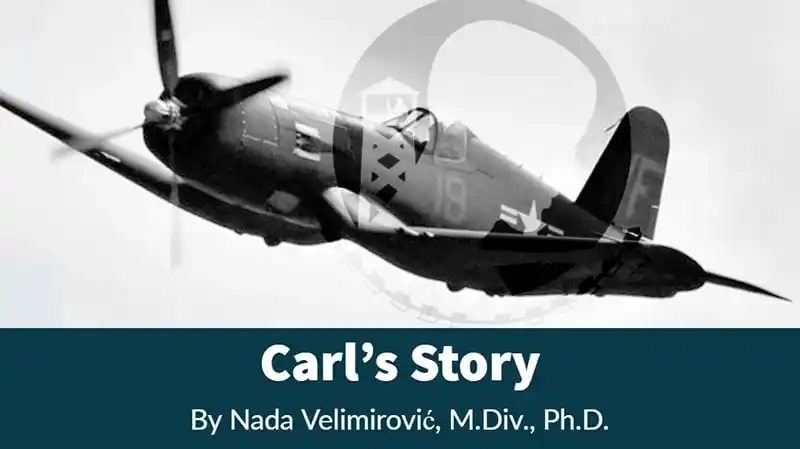Carl’s Story
By Nada Velimirović, M.Div., Ph.D.
“It had sawdust on top,” he said, reaching his hand out as if to shape the top of the remembered loaf of bread.
Carl is a 95-year old man in the care of Suncrest Hospice, whom I have been visiting for the last several months. Carl’s only family connected to him is a niece, who describes him as, “Tight-lipped; doesn’t talk a lot.” When Carl came on our service she said there was one story she was curious about in his life. Her father, Carl’s brother, told her that Carl served in the Air Force in World War II, flew bombing missions and was shot down over Germany, where he was rescued by nuns, then captured and sent to a prison camp. “You’d never know by talking to him,” said his niece. She added, “Now that he’s approaching the end of his life, I wonder if he needs to talk about it. As far as I know he’s never told anyone about his experience as a prisoner of war.”
In my role as Spiritual Care Coordinator, I try to engage both our hospice patients and their family members in conversations about what is most meaningful to them. This can mean conversations about their beliefs and faith, their scientific grounding, and/or a sense of mystery. We can connect through stories, meditation, music, prayer, and more stories.
Carl said he had “no interest” in religion or faith. During our first encounters his answers to my questions were brief, either “yes,” “no,” or “not really.” Open-ended questions were met with a shrug and he spent most of the time looking down. Occasionally I could coax him to make eye contact, but he never really looked at me. He said his eyesight was “fading.”
“Thirty missions! I flew thirty missions all over Germany!”
Over several visits, I managed to piece together a sparse outline of his life. He was born and raised in a small town in the Upper East Bay of the San Francisco Bay Area; served in the Air Force in World War II; worked in the sheriff’s department; and, finally, as a marshall in a county court house. Once he retired, he enjoyed playing golf. One time while visiting Carl, I leaned back, taking in the almost-bare decor of his room, when I noticed a few photos that had been obscured on earlier visits. Picking up a formal, black and white studio portrait of a woman, probably from the 1940s judging by the hairstyle, I held the portrait up close to Carl and asked, “Who is this?” His features pinched, his shoulders began to shake–I realized he was crying, but trying desperately to fight it.
Tears welled up in the corners of his eyes and the shaking spread, engulfing his whole body in grief as he sat there in his electric scooter. After a long pause, he opened his eyes and looked directly at me. He held his hand out for me to hold and said, “That’s my wife.” He just sobbed for the rest of our time together. When he stopped crying, he looked at me again and said, “Thank you.”
That visit was a turning point. Carl seemed to have given me permission to keep asking questions. So I did. And although sometimes it felt as though we were back to the beginning, with monosyllabic answers and shrugs, he always cried when I asked about his wife. It came out that he felt responsible for her death–that somehow he could have prevented the fall that resulted in her steep decline and death.
“We ate bread made of sawdust, ground glass, and barley.”
I began asking him directly about his experiences during the war. He initially said he didn’t remember much about his past. Then, once, he said, “What good does it do to talk about it?” When I suggested that some people find healing in expressing their stories, he merely grunted in response. I shared stories that had been shared with me by others, of what it can mean to survive war zones. Carl would just shrug his shoulders. I felt stumped. Consulting with my supervisor, a veteran herself and director of the “We Honor Veterans” program at Suncrest, she suggested inquiring about what message Carl would want this generation to learn from his experience of war. So I asked. This question was met with another shrug and a dismissive, “I don’t know.”
One morning I came across an obituary of a 93-year old man who had served as an Army medic in World War II. He’d been captured by German soldiers, forced to march through snow with no boots, and held in a prison camp. Somehow this medic had been able to keep and hide a diary, in which he documented the deprivation, torture and deaths of other prisoners, who were often shot for trying to escape. Ultimately, what he documented was his own survival. I put the article in my work bag.
On my next visit to Carl, I brought my colleague, medical social worker Jacque Stokes, and the article. When I asked Carl if I could read some excerpts to him, he said, “Sure.” Part way through a description of the scarcity of food, and how they ate bread made of sawdust, ground glass, and barley, Carl interjected, saying, “Our bread–it had sawdust on top.” I paused. He looked directly back at me. Through the exchange following that recollection, I learned he’d been held in two prison camps. “They moved us by boxcar to the Russian front when Allied troops got too close.” He said he was cold all the time, as they had no blankets, just the clothes on their backs. “It was freezing.” There was very little food, “But,” he conceded, “the Germans who guarded us weren’t any better off than we were.” Carl looked over my head and hit his fist on the arm of his scooter. “Thirty missions! I flew thirty missions all over Germany!” His right hand moved as if tracing the shape of the map of the country as seen from the air. “Then, on the thirtieth…,” he choked up, crying hard, slamming his fist down again. After a pause, my colleague Jacque stepped in with a gentle voice, reminding Carl that he’d survived, reminding him of where we are now, in a peaceful place, on a beautiful sunny day. Later, Jacque shared with me this was a vital technique in addressing PTSD, and the importance of not leaving veterans in the midst of their worst memories. A few minutes later, Carl reached out to hold my hand, saying, “Thank you,” several times.
I cannot know whether allowing Carl to share his stories has helped him to feel peace–but I do hope so. I continue to visit him, and some days his memory seems more faded than others. I hope that in those moments of releasing the stories bound up inside of him, he feels safe, respected, and honored. I do know that what he shares is a gift, entrusting us with his stories, which can now become part of our collective history and memory.
Sold Out hospice stories on our hospice blog
Please feel free to contact us with any questions regarding hospice care


